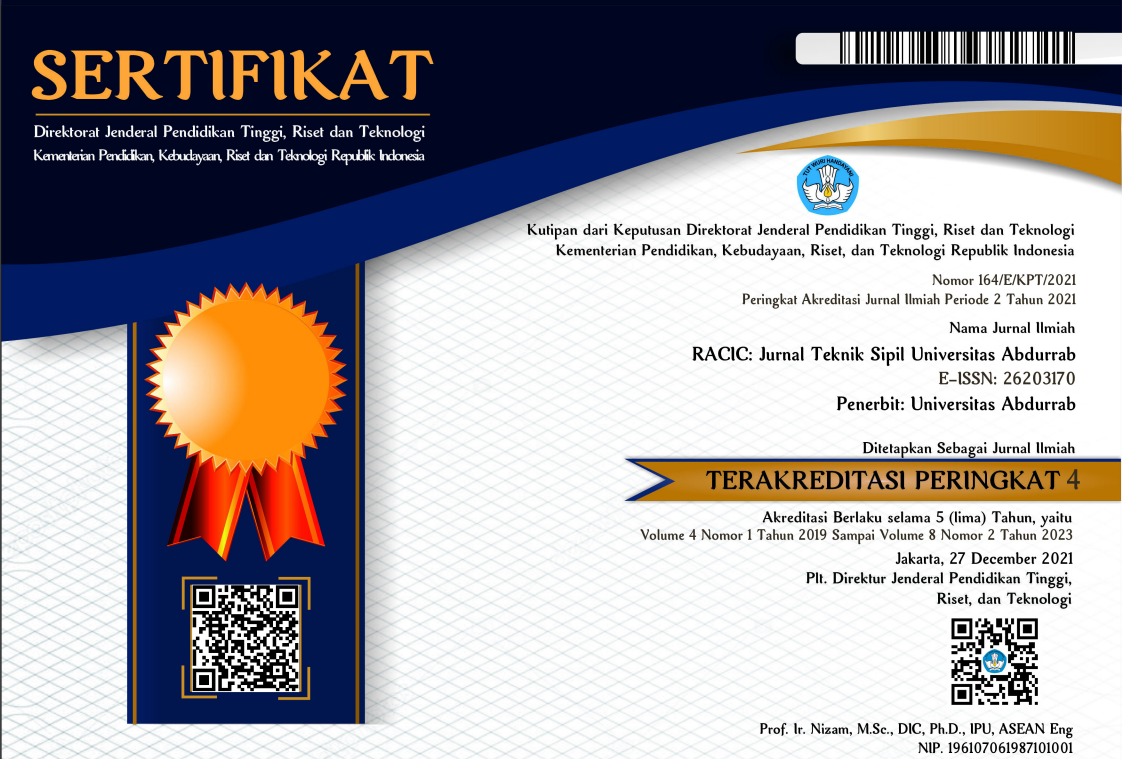PENGARUH PERUBAHAN TUTUPAN LAHAN TERHADAP ALIRAN PERMUKAAN PADA SUB DAS KAMPAR KANAN
DOI:
https://doi.org/10.36341/racic.v6i1.1540Keywords:
Kata Kunci: Pengelolaan DAS, SWAT, Penggunaan lahan, kinerja DASAbstract
Kampar watershed has a length of 580 km, with a catchment area of 21,086 km2, a maximum discharge of 2,200 m3 / s, a minimum discharge of 49 m3 / s. The largest level of damage in 4 major watersheds in Riau Province is located in the Kampar watershed, reaching 5,986 hectares. This study aims to analyze the effect of changes in land cover on surface runoff in the right sub-watershed using SWAT (hydrological model (soil water assessment tool). From the research results, changes in land use from 2009 to 2018 tend to increase precipitation from 3866.33 mm to 4687.94. Significant changes occurred in the water yield or the total amount of water entering the main river during the simulation period from 1722.65 mm to 3633.75 mm. The results of the calibration using the monthly discharge data from 2010 - 2011, the results of observations and predictions on the Lake Bingkuang SPAS were 276.70 m3 / s and 354.98 m3 / s. The results of the validation using the monthly discharge data for 2018 are 115.63 m3 / s and 93.03 m3 / s. The weight value and score of each performance of the right Kampar Sub-watershed in 2009 - 2018 shows that the percentage of vegetation cover (PPV) with a weight of 20%, a score of 0.5. Flow Regim Coefficient with a weight of 5%, a score of 0.75, while the annual flow coefficient with a weight of 5%, score, 0.5. The total number of watershed performance assessments with a weight of 30%, a score of 1.75, and the results of the assessment is 16.25 so that the performance results of the right Kampar Sub-watershed is 0.54.
Downloads
References
[2] Arnold, J.G., Kiniry J.R.,Williems, J.R., 2005. Soil and Water Assessment Tool Theoretical Documentation version 2005, Agricultur Research Servic US,Texas, http://www.http.brc.tamus.edu/swat/document.html, [31 Oktober 2015].
[3] Hambali, R. 2008. Analisis Ketersediaan Air dengan Model Mock. Bahan Ajar. Yogyakarta : Universitas Gajah Mada
[4] Harto S.1993. Analisis Hidrologi. PT Gramedia Pustaka Utama. Jakarta. 300 hal.
[5] Junaidi E., 2009. Kajian Berbagai Alternatif Perencanaan Pengelolaan DAS Cisadane Menggunakan Model SWAT, Tesis, Institut Pertanian Bogor, Bogor.
[6] Mangundikoro, A., 1985. Watershed Management in Indonesia. Proc. Of the Symposium on Watershed and Conservation for Productive and Protective Uplands in ASEAN Region, College, Laguna, Phillippines, 25-29 June 1984.
[7] Motovilov, Y.G., Gottschalk, L., Engeland, K., Rodhe, A., 1999. Validation of a Distributed Hydrological Model Against Spatial Observations, Elsevier Agricultural and Forest Meteorology, 98 : 257-277.
[8] Neitsch, S.R., Arnold, J.G., Kiniry, J.R., Srinivasan, R., Williems, J.R., 2005. Soil and Water Assessment Input/Output File Documentation version 2005, Agricultur Research Servic US, Texas. http://www. http.brc.tamus.edu/swat/document.Html, [31 Oktober 2015].
[9] Ridwansyah, I, H. Pawitan, N. Sinukaban, dan Y. Hidayat, 2014, Watershed modeling ArcSWAT and SUFI 2 in Cisadane catchment area : Calibration and validation to prediction river flow, International Journal of Science and Engineering (IJSE) 6 (2) : 12 -21.
[10] Rau M.I., 2012. Analisis Debit Sungai Dengan Menggunakan Model Swat Pada Das Cipasauran Banten, Skripsi, Institut Pertanian Bogor, Bogor.
[11] Santhi, C., Arnold, J.G., Williams, J.R., Dugas, W.A., Srinivasan, R., dan Hauck, L.M., 2001, Validation of The SWAT Model on A Large River Basin With Point and Nonpoint Source, Journal of The American Water Resources Association, October 2001, Vol.37, No.5, American Water Resources Association.
[12] Santika, P, 2017. Skenario Pengurangan Banjir Berdasarkan Tata Guna Lahan di Daerah Aliran Sungai Kedurus Menggunakan Model Hidrologi SWAT
[13] Singh, V.P., A.W. David. 2002. Mathematical Modeling of Watershed Hydrology. Journal of Hydrology Engineering. American Society Civil Engineering. p270-292.
[14] Wibowo, S., 2004. Masalah Degradasi Lahan dan Upaya Rehabilitasi Hutan dan Lahan. Prosiding Seminar Degradasi Lahan dan Hutan, Masyarakat Konservasi Tanah dan Air Indonesia, Universitas Gadjah Mada dan Departemen Kehutanan.
Downloads
Published
Issue
Section
License
1. Copyright of all journal manuscripts is held by the RACIC : Rab Construction Research
2. Formal legal provisions to access digital articles of electronic journal are subject to the provision of the Creative Commons Attribution-ShareAlike license (CC BY-NC-SA), which means that RACIC : Rab Construction Research is rightful to keep, transfer media/format, manage in the form of databases, maintain, and publish articles.
3. Published manuscripts both printed and electronic are open access for educational, research, and library purposes. Additionally, the editorial board is not responsible for any violations of copyright law.
licensed under a Creative Commons Attribution-ShareAlike 4.0 International License.





